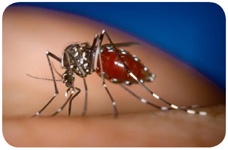This is the (insert string of expletives here) type of mosquito that infected me with Dengue Fever and made the last two weeks so miserable.

Check out the World Health Organization fact sheet on dengue for lots of fascinating facts, like these: The Aedes aegypti mosquito lives in urban habitats and breeds mostly in man-made containers. Unlike other mosquitoes Ae. aegypti is a daytime feeder; its peak biting periods are early in the morning and in the evening before dusk. Female Ae. aegypti bites multiple people during each feeding period.
I know exactly where and when the little bastard got me. I was just sitting down to dinner with two girlfriends at one of my favorite little restaurants in the funky Hauz Khas neighborhood when I felt the suspicious itch of a new mosquito bite on my ankle. Just as predicted by WHO, symptoms started about a week later. As usual, I had doused myself in mosquito repellant, joking that I was statistically more likely to get DEET poisoning than any mosquito-borne tropical illness. I double-jinxed myself with the stupid quip that dengue would make a cool blog post. Let me make it clear up front that the opportunity to share my first-hand account of dengue in NO WAY redeems the experience.
Here’s how it played out.
Sunday, Oct. 14, I was goofing around at my computer, when suddenly, my back felt like someone had just bashed it with a lead pipe. It came on that fast. One second, I was sitting up tall, feeling fine. The next second, I was crumpled on the bed. Dengue is sometimes called “broken bone disease,” and now I know why. If any part of my body made contact with any surface, the pain was unbearable. I couldn’t lie down or even sit in a cushy chair, but I didn’t have the strength to hold myself upright. It truly felt like all my bones were broken. That lasted for two days.
My temperature hovered around 102 degrees for several days, but I thought I was well enough by Thursday, Oct. 18, to attend parent conferences at school. I muddled through four meetings and then conceded I wasn’t strong enough to return for the next day’s conferences. I contacted Martin, the phlebotomist recommended by our school, who came to my house to take blood for the dengue test. It came back negative, and another test two days later also returned a negative report. Our school doctor suggested I might just have some random virus.
On Friday, a couple new symptoms started. A rash blanketed my chest and back but didn’t bother me too much. However, the palms of my hands felt like electrical worms were burrowing around, causing spastic jolts of intense burning. Ice packs provided the only relief, but you can’t just cling to ice. It gets too cold, and you have to take a break. But the minute I would let go, the stabs of fire would start again. Even if I held on for dear life, the ice eventually melted, and I had to get out of bed to put the packs back in the freezer. I spent two sleepless nights sobbing with fiery hands.
The middle school play took my mind off my symptoms for a few hours on Friday and Saturday. I had organized the make-up crew, but because of my illness I had missed the dress rehearsal. I know they would have been just fine without me, but I couldn’t stand to skip the shows. Friday, I helped the make-up crew set up their supplies, and I stuck around till the curtain call to supervise their work and clean-up. By Saturday, I knew I wasn’t up for a repeat performance. I trudged in for the matinee, got the group started and then headed home before intermission. From all accounts it went fine, but I felt so frustrated not to participate 100 percent.
A week after the symptoms started, I dragged myself out of the house for a second opinion. I visited the office of Dr. Chawla, a gentle Sikh physician, who gave me hard-core antihistamines to stop the electric worms and administered another blood test, which came back positive for dengue. He phoned me later and warned that my blood platelets were low, so I returned to his office on Monday for more blood work. Fortunately, that test showed my platelets rebounding.
During the first 10 days or so, I couldn’t even sit up in bed. I couldn’t read. I couldn’t check my email. I tried to FaceTime and Skype with friends and family, but I couldn’t hold up the iPad for more than a few minutes, and the constant headache behind my eyes made conversation uncomfortable. I had to force myself to eat and drink. At one point, I slept for about 18 hours. Tony came home from work and had trouble rousing me.
Now, two weeks later, I have minor burning in my hands and my energy level is nearly nonexistent. I can’t imagine how I’ll get up for school tomorrow after missing two weeks. The crazy thing is I had a fairly MILD case of dengue! We have friends here and in Laos who suffered far, far worse symptoms than I had. My parents had a driver in Saudi Arabia, whose young daughter died of dengue in Sri Lanka. I escaped relatively unscathed.
As of yesterday, New Delhi had reported 835 cases of dengue, including two deaths, this year so far. The “dengue season” generally extends from the end of the monsoon in September, when standing water provides prime mosquito breeding areas, until temperatures drop enough to discourage mosquito reproduction, which should be in the next few weeks.
There is no vaccine or cure, although Indians offer plenty of ayurvedic treatments for the symptoms. For example, I am drinking liquified papaya tree leaves each morning in the hopes it will restore my strength. It’s worth a shot!
